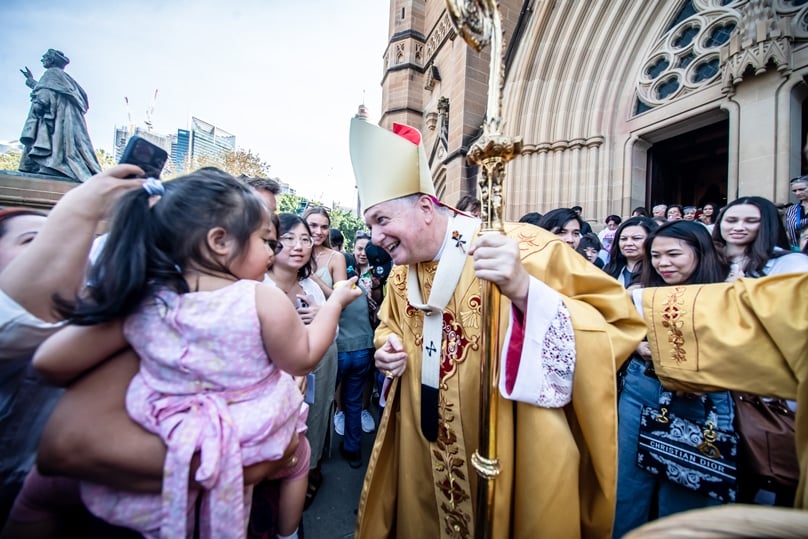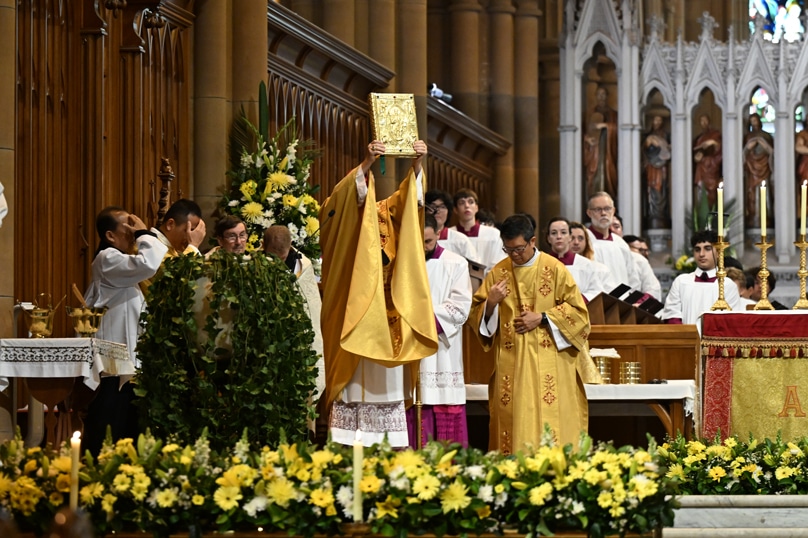
It’s the holiest place on earth—the Basilica of the Holy Sepulchre in Jerusalem—and on entering it the first thing you see is the Stone of Unction, traditionally the slab upon which Joseph of Arimathea and Nicodemus laid out the dead Jesus to embalm Him (Jn 19:39-40). Last year I was blessed to visit that place with Father Lewi: a year later and the Holy Land is effectively closed to pilgrims. So let me give you a brief tour…
The Holy Stone is a large block of rose limestone, encased in a marble frame, that looks rather like a grave. It’s flanked at each corner by five-metre-high candles with large silver lamps hanging above. On the wall behind is a shimmering mosaic of Christ being taken down from the cross and prepared for burial. Nearby are the actual sites of Golgotha, where Christ was crucified, and the ædicule or ‘little house’ encasing His tomb. Despite the best efforts of ancient Jewish authorities and Roman overlords, of Persian invaders and then Saracens to deter them, pilgrims have come to the site ever since Christ’s resurrection. A basilica was built over it by the emperor Constantine (326), destroyed by the Persians (614), rebuilt by the Byzantines (630), long protected by Muslim invaders (C7th onwards) but then destroyed by the fanatical 11th-century caliph, al-Hakim (1009). A new basilica was built by the Byzantine Greeks and the Latin crusaders (C11th & 12th), and maintained during the Ottoman empire by Greek Orthodox and Franciscan monks (C13th onwards). This church survived until the nineteenth century when it was destroyed by fire (1808), rebuilt (1809-10) and then maintained under British mandate (1918-48) and now in the state of Israel.
The first clear record of the Holy Stone of Unction is in the journal of a thirteenth-century Florentine Dominican friar, travel writer and missionary, Riccoldo da Monte di Croce. In the travelogue of his pilgrimage to the Holy Land (1288), he gave a detailed account of the Via Dolorosa tracing Christ’s final journey, all the way to the Unction Stone. The present church is oriented so that Holy Stone greets the pilgrim before progressing to the sites of Calvary, the Sepulchre and other chapels. Monks incense the stone and the faithful queue to kiss it, lay objects upon it, or rub it with oil or rose-water, as if they were embalming the Lord themselves. It is surely the most anointed and caressed stone in the world.
Anointing features throughout the Easter Story. In our first reading this morning (Acts 10:34-43), Peter preaches that Jesus “was anointed with the Holy Spirit and with power” to do good and combat evil. On Palm Sunday St Mark’s Passion began with an unnamed woman of Bethany at the house of Simon the Leper anointing the Lord’s head with nard (Mk 14:1-9); in an alternative account, Mary the sister of Martha and Lazarus, also of Bethany, did the anointing, but of Jesus’ feet (Jn 12:1-8). Either way, the Lord’s body was being prepared in advance for burial, but Mary’s foot-washing also foreshadowed Jesus doing the same for His men on the night of His Holy Grail and unholy betrayal (Jn 13:1-20). On Good Friday, at the end of St John’s Passion, we heard that after Jesus was thrust through with the Holy Lance, His friends Joe and Nick obtained His body for anointing with a great weight of aloes and myrrh, before wrapping and burying it (Jn 19:39-40).

Finally, in this morning’s Gospel, a fourth anointing is in prospect, when Mary of Magdala arrives with spices to finish the job she couldn’t trust the men to have done right (Jn 20:1-9). But on arrival she finds no body and runs off to tell Peter and John.
Now the boys come running and it’s their turn to find the tomb empty. It’s a conundrum. Did Mary of Bethany, Joseph and Nicodemus anoint a body for death and decay, or were they anointing Death itself with the Body of God-made-man? The Son of God didn’t need to rise from the dead: He could have cast aside His mortal nature and continued blissfully at God’s right hand. It was for our sake that He rose—for Jesus’ bodily resurrection is a promise to us all. As the Holy Grail of Maundy Thursday told of healing for now and hope for a time where there will be no more sickness; as the Holy Lance of Good Friday spoke of peace for now and the dream of a world without violence; so now the Holy Stone of Easter proclaims an end to death and a future of light and life and love.
Christ Risen means Death itself has been anointed and rededicated, now as the door to eternal life, when all is purged and forgiven, all restored and renewed, all is beauty and rest. Some of you here this morning are suffering deadly sickness or chronic pain; some, aches of heart or spirit; some are anxious about war, climate, finances, family; some worry about the future or for someone they love; some are lonely or mourning what’s lost. For you the empty tomb might seem a symbol of an empty heart, of lack of meaning, purpose and hope.
The beloved disciple saw the tomb was empty and “he believed”. But what did he believe? That it was empty? That didn’t require faith, just open eyes. It was by faith he knew what this empty tomb meant. Not, as some claimed, that Jesus had not really died. Not, as others alleged, that His disciples had stolen His body. Not, as some speculated, that gripped by grief, hysteria and wishful thinking the disciples didn’t notice that the body was still there. No, John—the very same young John who ran fastest to the tomb—records in our Gospel that “till this moment they had not understood the teaching of Scripture that Christ must rise from the dead”.
Now they knew, and so do we! To all of us, especially anyone anxious at this time, Christ’s resurrection says: “The suffering ends. See, I have risen and so will you. By my power, all will be well!”
